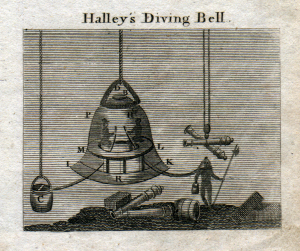For centuries people have been interested in going beneath the sea. Ancient manuscripts contain depictions of early divers. Century old artifacts imply people dove for valuable materials such as pearls [1]. This interest in the sea pushed people to develop ever-improving methods of staying underwater for longer periods of time at ever increasing depths.
[1] 500 BC Scyllis demonstrates practical use of breath-hold diving by performing military style exploits for the King of Persia or Aristotle mentioned the use of the diving bell in 4th Century BC ‘…they enable the divers to respire equally well by letting down a cauldron, for this does not fill with water, but retains the air, for it is forced straight down into the water’
Throughout the history of diving humans have been trying to attain a better understanding of pressure related illnesses and why they happen. This history and research is very useful today in the understanding and treatment of these diseases.
- 500 BC – Heroditus tells the story of Scyllis, who used a reed to breathe as he cut the mooring lines of Persian ships
- 1530 – First diving bell was invented.
- 1650 – Invention of the air pump; with this pump Robert Boyle is able to undertake experiments in compression and decompression of animals.
- 1667 – Boyle observes bubbles in a Viper’s eye after undertaking an experiment. He writes: “I have seen a very apparent bubble moving from side to side in the aqueous humor of the eye of a viper at the time when this animal seemed violently distressed in the receiver from which the air had been exhausted.“ This is the first ever record of Decompression Sickness or the ‘bends’
- 1690 – Edmund Halley patents the diving bell, dives to over 20m (60 feet) for 90 minutes are recorded.
- 1837 – During this project, decompression sickness became known as ‘The Bends’ because victims characteristically bended their backs.1837 – Dr. Andrew Smith first used the term ‘caisson disease’ when describing the 110 cases of decompression sickness during the construction of Brooklyn Bridge.
- 1873 – Dr. A.H. Smith presents his report about the builders of Brooklyn Bridge who suffered from the bends after leaving the pressurised caisson. It recommended chamber recompression for future projects but failed to mention the true cause of decompression sickness: nitrogen bubbles.
- 1878 – Paul Bert publishes ‘La Pression Barometrique, a 1000 page work showing that decompression sickness comes from the formation of nitrogen gas bubbles, he suggests a gradual ascent to the surface, he also shows the pain can be relieved through recompression. Bert provides links between Boyle’s 17th Century observation on decompression sickness in the viper and the symptoms of the compressed air workers in the 19th Century.
- 1900 – Leonard Hill used a frog model to prove that decompression causes bubbles and that recompression resolves them.
- 1908 – J.S. Haldane, A. E. Boycott and G. C. Damanthis publish their landmark paper on decompression sickness, ‘The prevention of Compressed Air Illness’. Diving tables on their work were soon created.
- 1916 – The decompression chamber was invented by the Italian engineer Alberto Gianni.
- 1924 – The US Navy published the first standardised recompression procedure
- 1930s – Albert R Behnke seperated the syptoms of AGE from those of DCS
- 1942 – Jacques-Yves Cousteau design and patent the Aqua Lung. The Aqua Lung is still used today by many divers.

Haven’t dropped by in a bit! I hope all is well and that your holiday was a good one! 🙂
Cheers OM! If I’m honest I haven’t dropped by my own blog in a while…oops… Hope you had a good holiday also and happy new year! Thanks for the visit 😉
I did indeed and I am glad to hear you are doing ok! 🙂